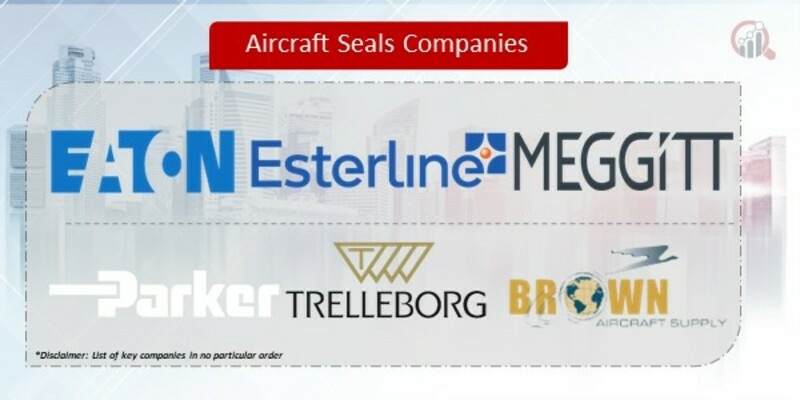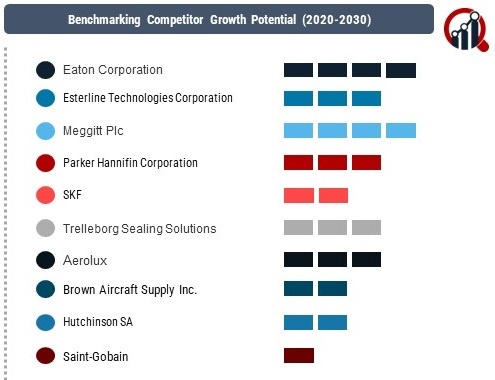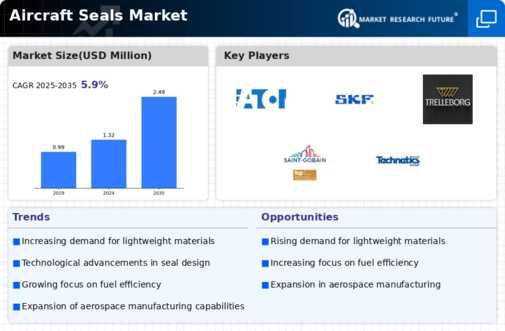Top Industry Leaders in the Aircraft Seals Market

Key Players :
Eaton Corporation (Ireland)
Esterline Technologies Corporation (US)
Meggitt Plc (UK)
Parker Hannifin Corporation (US)
SKF (Sweden)
Trelleborg Sealing Solutions (Sweden)
Brown Aircraft Supply Inc. (US)
Hutchinson SA (France)
Saint-Gobain (France)
and Technetics Group (US).
Strategic Alliances and Collaborations:
In the highly specialized field of aircraft seals, strategic alliances and collaborations are pivotal. Companies are increasingly forging partnerships to pool resources, share expertise, and accelerate innovation. These collaborations not only foster the development of cutting-edge technologies but also provide a platform for market leaders to maintain and expand their dominance. Joint ventures and strategic partnerships between key players enhance their capabilities and position them as comprehensive solution providers in the market.
Factors for Market Share Analysis:
Several factors contribute to the determination of market share in the aircraft seals industry. Technological innovation, product performance, pricing strategies, and global reach are key factors influencing market share dynamics. Companies investing in research and development to create technologically superior seals gain a competitive advantage. Additionally, strategic pricing and effective supply chain management play a crucial role in securing market share, especially in a market where cost-effectiveness is a significant consideration for airlines and aircraft manufacturers.
New and Emerging Companies: While established players dominate the aircraft seals market, the industry also sees the emergence of new and innovative companies. These newcomers often bring fresh perspectives and agile approaches to the market. Start-ups are leveraging advancements in materials science and manufacturing technologies to develop seals that offer improved performance, durability, and ease of installation. These emerging companies challenge established norms, fostering healthy competition and contributing to the overall growth and dynamism of the aircraft seals market.
Industry News and Developments: Staying informed about industry news and developments is crucial for companies operating in the aircraft seals market. Rapid advancements in aviation technology, changes in regulatory frameworks, and breakthroughs in materials science can significantly impact the competitive landscape. Companies that stay ahead of the curve in adopting the latest technologies and responding to industry trends are better positioned to navigate market shifts and capitalize on emerging opportunities.
Investment Trends:
Investment trends in the aircraft seals market reflect the industry's trajectory and future prospects. Companies are allocating resources to research and development, capitalizing on opportunities in emerging markets, and investing in sustainable and eco-friendly technologies. Investors are keenly watching for companies that demonstrate a commitment to innovation, environmental responsibility, and strategic growth initiatives. Companies that align with these trends are likely to attract greater investor interest and support.
Overall Competitive Scenario:
The overall competitive scenario in the aircraft seals market is characterized by a delicate balance between established players, innovative newcomers, and the continuous pursuit of technological excellence. Market leaders are keen on maintaining their positions through a combination of strategic partnerships, continuous innovation, and a focus on customer needs. At the same time, new entrants bring disruption and drive the industry forward by challenging traditional approaches and introducing novel solutions. The industry's future will be shaped by the ability of companies to adapt to evolving market dynamics, embrace technological advancements, and foster a culture of innovation.
Parker Hannifin Corporation:
Launched a new line of high-temperature seals specifically designed for next-generation engines, capable of withstanding extreme operating conditions.
Partnered with a research institute to develop smart seals with embedded sensors, enabling real-time monitoring and predictive maintenance.
SKF:
Introduced a new range of low-friction seals for landing gear components, contributing to reduced fuel consumption and noise levels.
Collaborated with an airline to implement advanced maintenance programs focused on optimizing seal performance and extending service life.
Trelleborg Sealing Solutions:
Developed a novel material for seals based on recycled carbon fibers, promoting sustainability and circular economy practices in the industry.
Unveiled a digital platform for seal selection and maintenance recommendations, streamlining processes and improving efficiency for aircraft operators.


